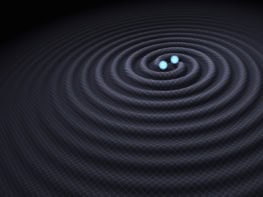By Louise Mayor in Waterloo, Canada
The search for ripples in space–time known as gravitational waves is one of my favourite scientific endeavours. So here at the Perimeter Institute’s Convergence conference, I couldn’t miss the opportunity to talk to Nergis Mavalvala, one of the speakers here.
A physicist at MIT, Mavalvala works on the Laser Interferometer Gravitational-Wave Observatory (LIGO) in the US. LIGO’s first six observing runs took place from 2002 to 2010 and yielded no detection of a gravitational wave. Since then, LIGO physicists have been working on increasing the instrument’s sensitivity – they needed to make it even better at measuring the stretching and compressing of the interferometers’ 4 km-long arms thought to occur if a gravitational wave passes through them.
Five years on, LIGO’s $200m upgrade is now complete.
“This current phase of LIGO, which is actually its second incarnation called Advanced LIGO, will begin its first observing run in September this year,” says Mavalvala. “It’s actually kind of a soft start – this first observing run will be at a sensitivity that’s roughly a factor of three lower than its final design sensitivity is meant to be.”
In 2010 LIGO could have measured a change in distance along its arms of 10–18 m. Following various improvements, the final design sensitivity planned for Advanced LIGO is 10–19 m. This factor of 10 increase equates to the observatory being able to probe a factor of 103 more volume of the universe, and all the many more neutron stars, black holes and other cosmic bodies contained within that space.
“So we’ll do an observing run for a couple of months and then we’ll go back into instrument improvement mode,” Mavalvala explains. “Then we’ll have another much longer observing run at the end of next year, at which point we expect that Advanced Virgo in Europe will also begin operating.”
What do the physicists working on Advanced LIGO expect to see once it’s up and running? “So Advanced LIGO at its final and full design sensitivity, you know, the world is our oyster,” says Mavalvala. “But initially with these lower sensitivities, the most likely sources that we expect to see are going to be the coalescences of binary neutron stars, or binary black holes, and in this case typically black holes that are just a few solar masses, not the very heavy ones.”
To find out more about gravitational-wave detection – there are three other methods that complement the terrestrial interferometry discussed here – and to learn how Mavalvala used quantum engineering to help improve LIGO’s sensitivity by a factor of 10, check out her talk, Exploring the warped side of the universe, filmed at Convergence on Monday.



